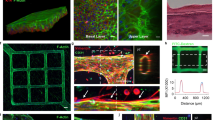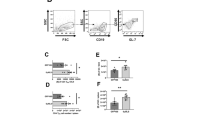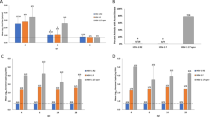Abstract
Current methods for sexually transmitted diseases (STD) prophylaxis, which can be disruptive and inconvenient, must be used before each act of sexual intercourse, so a method that provides protection over the course of many acts is desirable. We used a mouse model of vaginally-transmitted herpes simplex virus 2 (HSV-2) infection to test polymeric controlled-release devices for sustained passive immunoprotection. Vaginal disks were prepared by dispersing a monoclonal antibody to HSV-2 (111-174) within a matrix of poly(ethylene-co-vinyl acetate); these disks released 2 to 40 μg/day of antibody into buffered water. When disks were placed in the vagina, large amounts of 111-174 (5 to 3,000 ng) were recovered from the vaginal fluid over the next 8 days. Mice were vaginally challenged with 10 ID50 of HSV-2 either 3 or 7 days after disk placement; no mice receiving 111-174 disks became infected, while 65% of control mice receiving identical disks with nonspecific IgG did. Controlled-release disks with 111-174 provided significant protection against HSV-2 infection (p < 0.005). This new technology for long-term STD prophylaxis should increase user compliance, a factor limiting the efficacy of current methods.
This is a preview of subscription content, access via your institution
Access options
Subscribe to this journal
Receive 12 print issues and online access
$259.00 per year
only $21.58 per issue
Buy this article
- Purchase on SpringerLink
- Instant access to full article PDF
Prices may be subject to local taxes which are calculated during checkout
Similar content being viewed by others
References
Division of STD/HIV Prevention. Annual Report 1994. U.S. Department of Health and Human Services, Public Health Service. Atlanta: Centers for Disease Control and Prevention. September 1995.
Koutsky, L.A., Stevens, C.E., Holmes, K.K., Ashley, R.L., Kiviat, N.B., Critchlow, C.W., and Corey, L. 1992. Underdiagnosis of genital herpes by current clinical and viral-isolation procedures. N. Engl. J. Med. 326: 1533–1539.
Hook, E.W., Cannon, R.O., Nahmias, A.J., Lee, F.F., Campbell Jr., C.H., Glasser, D., and Quinn, T.C. 1992. Herpes simplex virus infection as a risk factor for human immunodeficiency virus infection in heterosexuals. J. Infect. Dis. 165: 251–255.
Stone, K.M. 1994. HIV, other STDs, and barriers, pp. 203–212 in Barrier Contraceptives: Current Status and Future Prospects. Mauck, C., Cordero, M., Gabelnick, H., Spieler, J., and Rivera, R. (eds.). Wiley-Liss, New York.
Cohen, J. 1995. Women: absent term in the AIDS research equation. Science 269: 777–780.
Para, M.R., Parish, M.L., Noble, A.G., and Spear, P.G. . 1985. Potent neutralizing activity associated with anti-glycoprotein D specificity among monoclonal antibodies selected for binding to herpes simplex virions. J. Virol. 55: 483–488.
Fuller, A.O. and Spear, P.G. 1987. Anti-glycoprotein D antibodies that permit adsorption but block infection by herpes simplex virus 1 prevent virion-cell fusion at the cell surface. Proc. Natl. Acad. Sci. USA 84: 5454–5458.
Whaley, K.J., Zeitlin, L., Barratt, R.A., Hoen, T.E., and Cone, R.A. 1994. Passive immunization of the vagina protects mice against vaginal transmission of genital herpes infections. J. Infect. Dis. 169: 647–649.
Sherwood, J.K., Zeitlin, L., Chen, X., Whaley, K.J., and Cone, R.A. 1996. Residence half-life of IgG administered topically to the mouse vagina. Biol. Reprod. 54: 264–269.
Elias, C.J. and Heise, L.L. 1994. Challenges for the development of female-controlled vaginal microbicides. AIDS 8: 1–9.
Feldblum, P. and Joanis, C. 1994. Modern Barrier Methods: Effective Contraception and Disease Prevention. Family Health International, Research Triangle Park, NC.
Zador, G., Nilsson, B.A., Nilsson, B., Sjoberg, N.D., Westrom, L., and Wiese, J. 1976. Clinical experience with the uterine progesterone (Progestasert). Contraception 13: 559–568.
Langer, R., Brem, H., and Tapper, D. 1981. Biocompatibility of polymeric delivery systems for macromolecules. J. Biomed. Mat. Res. 15: 267–277.
Rhine, W.D., Hsieh, D.S.T., and Langer, R. 1980. Polymers for sustained macro-molecular release: procedures to fabricate reproducible delivery systems and control release kinetics. J. Pharm. Sci. 69: 265–270.
Saltzman, W.M. and Langer, R. 1989. Transport rates of proteins in porous materials of known microgeometry. Biophys. J. 55: 163–171.
Saltzman, W.M., Radomsky, M.L., Whaley, K.J., and Cone, R.A. 1994. Antibody diffusion in human cervical mucus. Biophys. J. 66: 508–515.
Radomsky, M.L., Whaley, K.J., Cone, R.A., and Saltzman, W.M. 1992. Controlled vaginal delivery of antibodies in the mouse. Biol. Reprod. 47: 133–140.
Siegel, R.A. and Langer, R. 1984. Controlled release of polypeptides and other macromolecules. Pharm. Res. 1: 2–10.
Niruthisard, S., Roddy, R.E., and Chutivongse, S. 1991. The effects of frequent nonoxynol-9 use on the vaginal and cervical mucosa. Sex. Transm. Dis. 18: 176–179.
Cone, R.A. and Whaley, K.J. 1994. Monoclonal antibodies for reproductive health: part I. preventing sexual transmission of disease and pregnancy with topically applied antibodies. Am. J. Reprod. Immunol. 32: 114–131.
Whaley, K.J., Barratt, R.A., Zeitlin, L., Hoen, T.E., and Cone, R.A. 1993. Nonoxynol-9 protects mice against vaginal transmission of genital herpes infections. J. Infect. Dis. 168: 1009–1011.
Snedecor, G.W. and Cochran, W.G. 1980. Statistical Methods, 7th ed. The Iowa State University Press, Iowa.
Author information
Authors and Affiliations
Rights and permissions
About this article
Cite this article
Sherwood, J., Zeitlin, L., Whaley, K. et al. Controlled release of antibodies for long-term topical passive immunoprotection of female mice against genital herpes. Nat Biotechnol 14, 468–471 (1996). https://doi.org/10.1038/nbt0496-468
Received:
Accepted:
Issue date:
DOI: https://doi.org/10.1038/nbt0496-468
This article is cited by
-
Migrant memory B cells secrete luminal antibody in the vagina
Nature (2019)
-
Protein and oligonucleotide delivery systems for vaginal microbicides against viral STIs
Cellular and Molecular Life Sciences (2015)
-
Intravaginal rings: controlled release systems for contraception and prevention of transmission of sexually transmitted infections
Drug Delivery and Translational Research (2011)
-
Intravaginal gene silencing using biodegradable polymer nanoparticles densely loaded with small-interfering RNA
Nature Materials (2009)
-
Inhibiting sexual transmission of HIV-1 infection
Nature Reviews Microbiology (2003)



